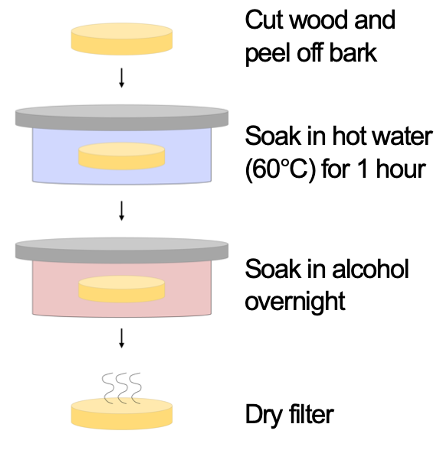We have provided brief answers to some of the most commonly asked questions on xylem filters. A detailed description of the technology can be found in our technical paper published in Nature Communications.
What type of trees can be used for creating xylem filters?
Gymnosperms (non-flowering plants) like pine, cedar, spruce etc. are better suited for creating xylem filters in comparison to angiosperms (flowering plants). This is because the length of the conduits in such plants is shorter, which allows for the creation of compact filters. In addition, the fraction of trunk or branch cross-section containing xylem is higher in gymnosperms, which provides greater membrane area. It is important to review the toxicity information of trees before creating these filters. For further guidance, please refer to the design guide in our ‘Filter manufacturing resources’ tab.
What drives the flow of water through a xylem filter?
Xylem filters can be operated by gravity. Pumps are not required.
How can one make xylem filters from trees?
Developing xylem filters involves four simple steps as illustrated in the schematic. A detailed description of these steps has been provided below.

1. Wood sourcing: Cut a section of branch or the sapwood present in the trunk. Peel off the bark. The wood should be green and the cuttings should be stored in water to prevent drying.
2. Soaking in hot water to improve capacity: Xylem filters have a unique self-blocking behavior. Xylem is composed of loose hemicellulose fibers that dissolve in the water flowing through the filter and re-deposit on the membranes clogging them. This imposes an intrinsic limit on the filter’s shelf life. To mitigate self-blocking, xylem filters can be soaked in hot water at 60 deg C for 1 hour. The temperature and duration of treatment has been optimized for removing sufficient fibers to improve capacity, while mitigating damage to pit membranes to preserve rejection. This step might not be needed if the external contaminant load is high.
3. Dry preservation for extending shelf-life: Drying causes the membranes in the xylem to seal against the cell wall and at times, damages them. This results in poor flow rates and rejection performance and thus, short shelf-life of xylem filters. To improve shelf-life, two methods for preserving filters in a dry format can be followed:
i) Alcohol treatment: Soaking the cut filters in alcohol (ethanol, isopropanol, etc.) before drying preserves the structural integrity of membranes and provides a shelf-life of at least two years.
ii) Controlling filter thickness: The flow rates of dried filters depends strongly on filter thickness. By maintaining a filter thickness of ~0.25 inches, reasonable flow rates can be obtained. In order to mitigate the leakage of contaminants through damaged pit membranes and improve rejection, multiple thin filters can be stacked in series. This method is useful in areas where access to alcohol is difficult, although quality control might be difficult.
4. Drying: Filters can be either air-dried or in an oven at temperatures up to 45 deg C.
What kind of contaminants can the filter handle?
With regards to microbial contaminants, xylem filters could provide >3-log removal of E. coli and MS-2 phage and >4-log of removal of rotavirus (based on tests conducted with filters made from ginkgo having 4 cm diameter and ~1 cm thickness operated under a 1.2 meter gravity head with General Test Water containing World Health Organization (WHO) prescribed concentrations of E. coli (>106 CFU/mL) and MS-2 phage (>105 PFU/mL) and National Sanitation Foundation (NSF)-prescribed concentrations of rotavirus (>104 PFU/mL)).
These filters can also handle physical contaminants like dust. The efficacy of these filters against chemical contaminants has not been evaluated yet.
What is the flow rate of these filters?
The flow rate in xylem filters scales linearly with sapwood area and pressure. These parameters can be adjusted to tune the flow rate to suit user needs. Filter area can be increased by increasing filter diameter or operating multiple filters in parallel. The permeance (flow rate normalized by area and pressure) of ethanol-dried filters and fresh filters is 0.01 L/h.cm2.kPa and 0.03 L/h.cm2.kPa, respectively. This is comparable to the permeance of commercial membranes with equivalent pore size, which is 0.002 – 0.05 L/h.cm2.kPa.
What is the capacity of xylem filters?
The capacity of xylem filters depends on water quality, filter design, and use of pre-filtration.
With WHO-prescribed General Test Water (GTW) that represents high quality groundwater, xylem filters have a capacity of 6.07 ± 4.40 L/cm2 when operated under a 1 meter pressure head. Xylem filters made from ginkgo with 4 cm diameter and ~1 cm thickness could process 34-84 L of GTW under 1 meter gravity.
Xylem filters are most susceptible to fouling by large organic molecules like humic acid and dust. With WHO-prescribed Challenge Test Water (CTW) having aggressive specifications and high concentrations of humic acid and dust, xylem filters have a capacity of 0.58 ± 0.47 L/cm2. Xylem filters made from ginkgo with 4 cm diameter and ~1 cm thickness could process 6-12 L of CTW under 1 meter gravity. Filter capacity with CTW can be improved by using simple, inexpensive pre-filtration methods. For example, cloth and granular activated carbon (GAC) could be used for reducing the load of dust and humic acid, respectively. With cloth and GAC pre-filtration, xylem filters with 4 cm diameter and ~1 cm thickness can process 26-31 L when operated under a 1 meter gravity head.
What is the lifetime of xylem filters?
Depending on water quality, filter design, and type of pre-filtration used, xylem filters might need replacement every 1-4 days. The flow rates are extremely slow at the end-of-life, signaling the need for replacement.
Have xylem filters been tested with natural water?
Yes, xylem filters have been tested with water from natural springs, tubewells (groundwater), and municipal taps in India. Filters made from Ginkgo Biloba (ginkgo) and Pinus roxbhurghii (chir pine) with 4 cm diameter and 1 cm thickness operated under a 1 meter gravity head and were able to process at least 10 L of water and showed complete removal of coliform (bacteria) in most cases.
